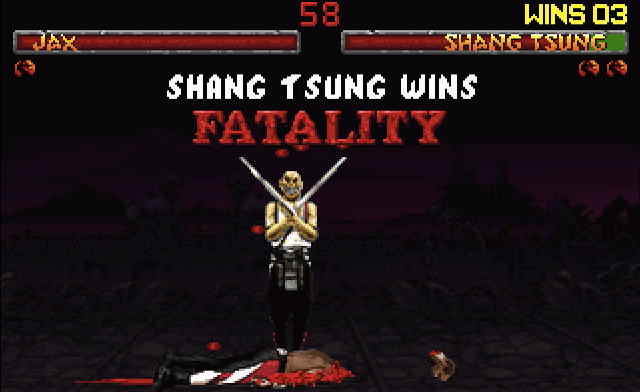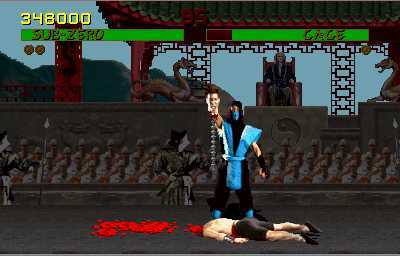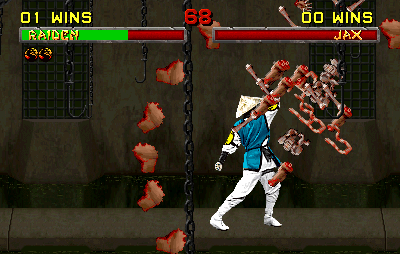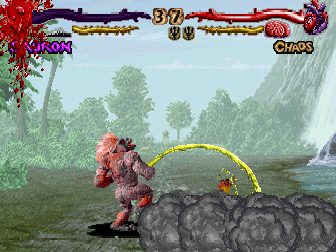Objectionable content
Posted by Maurice Pogue on October 5, 2012 · Comments Off on Objectionable content

I can’t pause the game because “Start” on my Sega Genesis controller is for blocking.
Instead, I jump around from one side of the screen to the other, hoping that I don’t jump on a fireball or impeccably-placed uppercut from the AI-controlled Johnny Cage as my dad passes through the room. I contemplate resetting the game, but I’ve already been playing for thirty minutes out of the hour I’m allotted on school days, and it would take another twenty or so to get this far on the tournament tree. Besides, I’ve only been able to successfully perform Sub-Zero’s fatality two out of five attempts as I have not quite mastered the timing on the inputs. The round timer is ticking down, and a TIME UP is a cheesy way to win. Besides, that would not provide an opportunity to perform a FATALITY!
Dad sits on the sofa, interested in evaluating the impact of his purchase, which means confirming if I am satisfied. He had gone to Wal-Mart the previous day to acquire the newly-released Street Fighter II: Championship Edition, which was a pretty big deal for Sega in those days as Nintendo had enjoyed a year of exclusivity of the now-legendary Street Fighter II on the Super Nintendo (Entertainment System). This new version of the game made bosses playable and Mirror Matches possible without a Game Genie. Unfortunately, dad got off from work at 5, and by the time he made it across town to our local store, they were sold out. So he picked up the newly-released Mortal Kombat instead, Capcom’s new rival franchise, thinking that its MA-13 rating was the equivalent of SFII:CE’s.
I cringe, knowing that the Genesis version of Mortal Kombat has a distinct advantage over its SNES counterpart that would go down in infamy:
A, B, A, C, A, B, B
Followed by a screen of text that nobody has ever read more than once and Scorpion’s “GET OVER HERE!” command,
With precision, I perform what would become a staple combo, freezing ice in the famous SF cast via the classic SF “fireball” motion followed by an uppercut and a slide whose inputs required me to release the controller with my right hand and use my thumb and middle-finger to hit the A and C buttons simultaneously with my index finger on the start button, and return my hand to its normal position — a technique of controller manipulation I would use in many, many fighting games such as Tekken and Soul Calibur for years to come.
“FINISH HIM!” the game demands of me. I grant its request.
F, D, F, A at close range rewards the innocent witness that is my father and me with a darkening background and menacing jingle as Sub-Zero stops halfway into his uppercut animation to remove poor Johnny’s head from his shoulders, blood dripping, spine attached, and raises his newfound trophy in a victory pose reminiscent of your favorite medieval (or if you’re like me, Sengoku-era Japan) film where the enemy general has been decapitated and his army surrenders in morale shock.

“Humph!” my father laughs nervously, “You sure you’re supposed to be playing this?” he asks incredulously, but no real threat.
I am ten years old at the time in 1993. “Yes, dad, I can handle it. I know I’m not supposed to do this to anyone in real life.” I say this in as a sort of plea, unaware that I wouldn’t even watch my first rated-R movie that didn’t have commercials to cut out all the “bad parts” until I was old enough to drive myself to the movies and buy the damned ticket myself.
Content, perhaps not by my answer, but rather by the fact that his son was making way into manhood for the first time, discovering that violence exists in the real world, and it can be filtered through a virtual environment, my dad left me to my hobby. “Well, as long as you know that it’s just a game” he would offer as conditional approval.
I would witness Mortal Kombat become a trailblazer in the games industry. Alongside Night Trap, which enjoyed a brief moment in the spotlight, and the Doom franchise that would follow a different trajectory than console-based games, gamers would experience revisions to the games rating system, and the emergent discourse known as “Video Game Violence” (VGV).
Ah, yes! You might be old enough to remember those days when the local or national news would continue to show clips of the games I have mentioned above even decades after their popularity had waned. If there was a more discrete indication of a disconnect between older audiences and younger generations (of gamers), it would be talking about VGV while showing scenes from the now-pixilated Doom II while gamers are playing Soldier of Fortune, a game whose engine was specifically designed to maim enemies as thoroughly as possible, even after death.
But I am getting ahead of myself. That’s the kind of game content that I feel goes too far, and that’s Part 2 of this piece. I would like to go back to games like MK2, which was one of the most highly-anticipated games of its day, and is the first game I remember going to the arcade (do those even exist anymore beyond Dave & Buster’s?) and learning to place a coin on the dashboard of the machine to indicate “I got next.” MK2 was FREAKING COOL just by virtue of how Midway continued to consciously contrast the SF franchise, preferring real-life actors in costume with Wrath of the Titans-style stop motion video capture. Furthermore, even with the hyper-violence of the new fatalities, such as torso tearing and arm ripping, the game demonstrated an ironic meta-awareness of itself. I’m not just talking about the added Friendships or Babalities as non-violent alternatives to what made the franchise famous, but the gratuitous increase of blood and gore rendered the game as comical as serious. Scorpion’s “GET OVER HERE” spear in MK1 resulted in a few drips upon contact. MK2‘s version results in wide-spray water hose effect. High Punches now make the blood splash to the floor in ways reminiscent to Sub-Zero’s MK1 fatality, a dramatic change from the first game’s mist evaporating in mid-air for the same move. Lastly, some fatalities are simply ridiculous, such as Raiden’s, my favorite character. Both of his fatalities cause his opponents to explode into gibs (gamerspeak for hard-to-identify body parts), which would be cool, except that oftentimes, gamers can count sometimes too many body parts in the pile!

Why couldn’t I hit him that hard during the match???
MK2 was innovative in many ways, but the exaggerated violence bordered crass in others.
 Remember when we were amused by bodily functions? Boogerman was a game built around them, but games like Primal Rage combined them with the added insult of being fatal. Though Primal Rage only earned a TEEN rating, this shot was quite the, yes, RAGE among “concerned parents.” (Read: Media bringing this to the attention of the otherwise oblivious)
Remember when we were amused by bodily functions? Boogerman was a game built around them, but games like Primal Rage combined them with the added insult of being fatal. Though Primal Rage only earned a TEEN rating, this shot was quite the, yes, RAGE among “concerned parents.” (Read: Media bringing this to the attention of the otherwise oblivious)
This, I think, was the beginning of when “mature” content in games began to go wrong as soon as it started. MK2, by the way, was among the first mainstream games to earn the “MA-17” rating by the ESRB.
Beyond the MK franchise, with rare exceptions such as Robocop vs The Terminator on the Sega Genesis, Lethal Enforcers, or Snatcher, VGV on 16-bit consoles was often limited. However, I distinctly remember in the ensuing 32-bit era, Resident Evil for the PS1, where I could shoot a zombie in the head at point-blank with a shotgun, and it would still walk toward me headless for three seconds, blood shooting in the air anime-style, before dying, where a dead zombie was “marked” to the player by a pool of blood around the corpse. I emphasize marked because a convention in the pre-RE4 days was to have a live zombie APPEAR dead, then scare the gamer by having the zombie grab and chomp on the player’s leg. The only way to confirm a dead zombie on-screen was the blood pool or no zombies at all.
Rockstar, as celebrated as it is infamous for pushing the boundaries of game content, would port over their flagship franchise Grand Theft Auto the PC to consoles(You can get GTA 1 and 2 for FREE by the way) with the pinnacle of its reputation not being an arbitrary naked male scene in its GTA4 expansion “The Lost and the Damned,” but a poorly-designed mini-game that was scrapped at the last minute but was discovered by datamining modders, now known as “Hot Coffee,” where the player could control the protagonist having sex with his various girlfriends.
It’s funny how far video games have come from the MK days. But then again, disturbing in others. far we Hot Coffee ain’t got *** on God of War III, where Kratos has off-screen sex with the goddess Aphrodite, as her buxom, buck-naked, suggestively bisexual concubines watch with eager anticipation and react to the player’s mastery of the on-screen button prompts. In the opposite direction, we have chainsaws on guns in games like Gears of War, and F-bomb marathons in The House of the Dead: Overkill for the Wii.
So it would seem that alongside the “nerds” who played video games in the mid to late-80’s through the 90’s, over time video games would evolve from something that just nerdy types would be interested into a medium demanding at times to be taken as seriously as we do Hollywood movies (so we’re not starting with arbitrary dates here, the post-video game crash and the emergence of Nintendo and the NES is where I would start when talking about from where the current video game industry has evolved). After all, we gamers have grown up, and our aesthetic palate would mature with us, right?
RIGHT???
I am not so sure. In my next piece, I would like to address this question of “mature” gaming that had emerged more poignantly than ever in this past generation, and how the division between “casual” and “hardcore” gaming alienated and solidified key sectors in the gaming industry. Like the fatalities of Mortal Kombat, it gets messy, folks.
—
Maurice Pogue spends his time spoiling the fun by taking the joke too seriously.
Filed under Confessions of an (Ex) Hardcore Gamer · Tagged with ESRB, fighting games, Mortal Kombat, Mortal Kombat II, Primal Rage, ratings, Street Fighter, video games, Violence